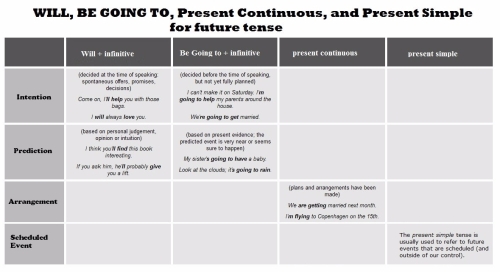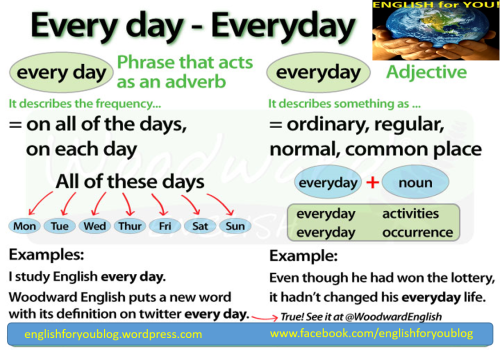
In this short post, I am going to share how to talk about future events and hopefully it will help you better understand and use the future tense.
Predictions/statements of fact
The auxiliary verb will is used in making predictions or simple statements of fact about the future.
- The sun will rise at 6.30 tomorrow.
- Today’s class will be 10 minutes longer than usual.
- In the year 2030 all students will have their own computers in school.
- If you help me, I will help you.
- I don’t think your brother will be home soon.
- You won’t pass your test if you don’t study.
- I know my mother won’t let me go to that movie.
- Will it snow on Christmas?
- I know she’s on holiday, but will she be back next week?
Intentions
The auxiliary verb phrase going to is used in talking about intentions. (An intention is something that you plan to do in the future that you have already thought about.)
- He’s going to buy a new motorcycle next week.
- I’m going to vacation in Asia when I graduate.
- Next year I’m going to start eating healthier.
- She’s not going to go to the movie. She has too much homework.
- I’m not going to watch the movie until I have finished my report.
- Are you going to play football this weekend?
- What are you going to have for dinner tonight?
Arrangements
The present continuous tense is used in talking about arrangements. (An arrangement is is a plan for the future that you have already thought about and discussed with someone else.)
- I‘m meeting my father in the city on Tuesday.
- Her parents are visiting us this summer.
- Sorry, I can’t meet after work today; I‘m playing basketball with Michael.
- Are you doing anything with Mary this weekend?
- Do you know if he is going to the dance with Sarah next week?
Scheduled events
The present simple tense is usually used to refer to future events that are scheduled (and outside of our control).
- Hurry up! The train departs in 5 minutes.
- She leaves Paris at 6 o’clock in the morning and arrives in New York at midnight the next day.
- He has an appointment with his boss at 3 this afternoon.
- There’s no need to hurry. The plane doesn’t leave for another 45 minutes.
- When does the meeting begin?
- Our online English class begins at 11 your time.
Click here to schedule a class over Skype – from conversation practice to test preparation and specific topics like Business English, improve your English skills with one-on-one sessions that fit your schedule. Skype @ alex.g.k5
And if you found this helpful, let others know about it – like and share:























